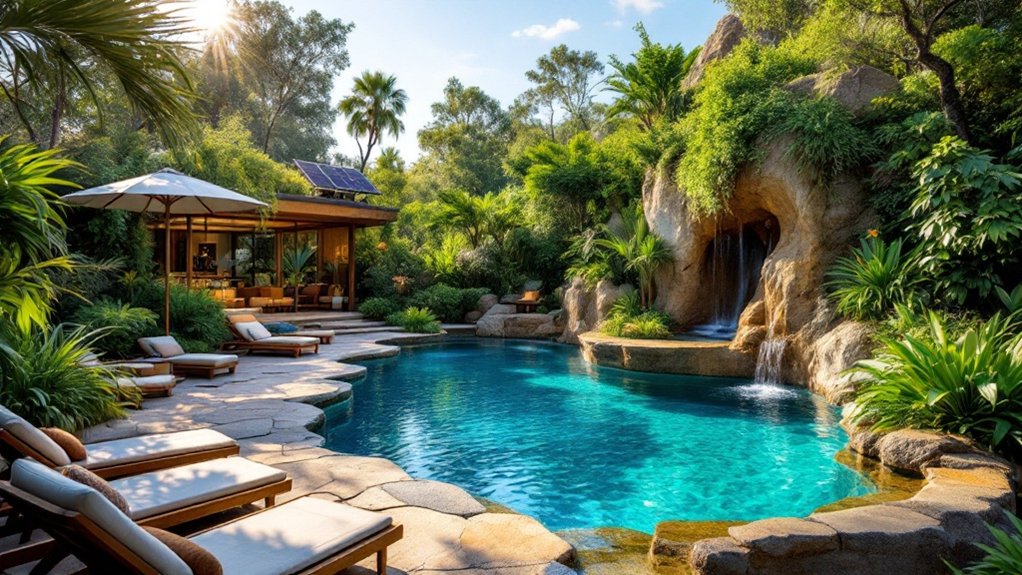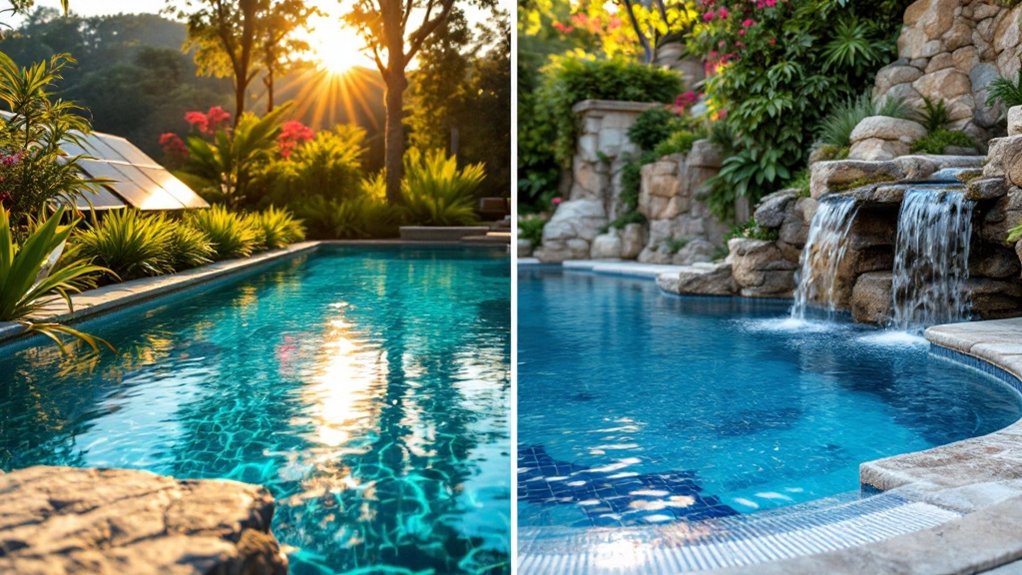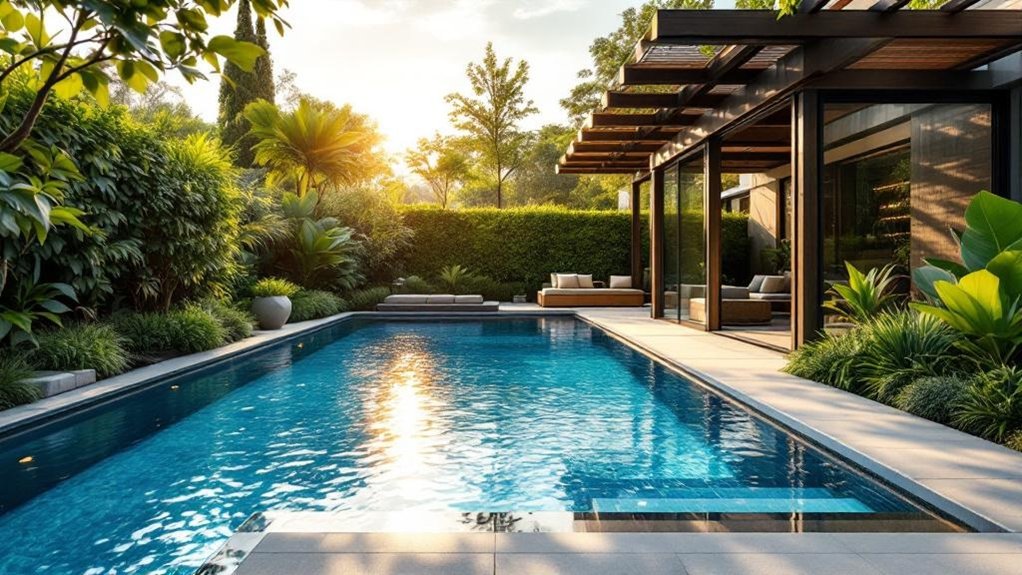Sustainable pool designs are reshaping how outdoor spaces are utilized. They incorporate eco-friendly materials and energy-efficient systems to enhance both aesthetics and environmental health. This approach not only supports local ecosystems but also offers homeowners a chance to enjoy luxurious retreats. As these designs gain popularity, several innovative features emerge, each contributing to a more sustainable future. The next steps in this evolution reveal intriguing possibilities for eco-conscious homeowners.
The Rise of Natural Swimming Pools
In recent years, an increasing number of homeowners have turned to natural swimming pools as an eco-friendly alternative to traditional chlorinated options. These pools utilize a biological filtration system, relying on plants and beneficial bacteria to maintain clean water without harsh chemicals. This innovative approach not only enhances the aesthetic appeal of outdoor spaces but also creates a sustainable ecosystem that supports local wildlife. Natural swimming pools typically feature a designated regeneration zone filled with aquatic plants that naturally filter the water. As awareness of environmental issues grows, homeowners are drawn to the health benefits and lower maintenance costs associated with these pools. The rise of natural swimming pools reflects a broader trend towards sustainable living and a desire for a more harmonious relationship with nature.
Eco-Friendly Materials for Pool Construction
In the pursuit of sustainable pool designs, the choice of materials plays a vital role. Utilizing recycled building materials and natural stone options not only reduces environmental impact but also enhances the aesthetic appeal of pools. These eco-friendly alternatives contribute to a more sustainable construction process while ensuring durability and style.
Recycled Building Materials
A growing number of pool builders are turning to recycled building materials to create eco-friendly swimming environments. These materials, which can include reclaimed wood, recycled glass, and repurposed metals, not only reduce waste but also lower the carbon footprint of pool construction. Utilizing recycled materials promotes sustainability by conserving natural resources and minimizing the environmental impact associated with traditional building methods. For instance, recycled concrete can be used for decking, while reclaimed wood can enhance poolside aesthetics. Additionally, using these materials often provides a unique, rustic charm that appeals to environmentally conscious homeowners. As awareness of sustainable practices grows, the integration of recycled building materials in pool design is expected to become increasingly prevalent, transforming outdoor spaces into eco-friendly retreats.
Natural Stone Options
Natural stone offers an elegant and sustainable option for pool construction, blending beauty with eco-friendliness. Materials such as slate, granite, and sandstone provide durability while minimizing environmental impact. These stones are sourced from quarries that prioritize responsible extraction methods, reducing carbon footprints. Additionally, natural stone enhances the aesthetic appeal of outdoor spaces, offering unique textures and colors that harmonize with the surrounding landscape.
In addition to their visual benefits, natural stones retain heat, contributing to energy efficiency in pool heating. They are also low-maintenance, reducing the need for chemical treatments and frequent replacements. Homeowners increasingly favor natural stone options, recognizing their ability to create luxurious yet sustainable pool environments that stand the test of time while respecting nature.
Energy-Efficient Pool Heating Solutions
While maintaining a comfortable water temperature is essential for enjoyable swimming experiences, traditional heating methods can lead to significant energy consumption and costs. To address these issues, energy-efficient pool heating solutions have emerged as viable alternatives. Solar pool heaters harness sunlight, converting it into warmth for the water, making them both eco-friendly and cost-effective over time. Heat pumps, which utilize ambient air to generate heat, also present an efficient option, providing consistent temperature control with lower energy usage. Additionally, pool covers can greatly reduce heat loss, ensuring that the water remains warm without excessive reliance on heating systems. By adopting these innovative solutions, pool owners can enjoy sustainable heating while minimizing their environmental footprint and utility expenses. Regular heater fan motor maintenance is also crucial for ensuring efficient operation and extending the life of the heating systems.
Smart Filtration Systems for Clean Water
As pool owners increasingly prioritize sustainability, smart filtration systems have emerged as essential tools for maintaining clean and clear water. These advanced systems utilize innovative technologies such as automated sensors and artificial intelligence to optimize filtration processes. By monitoring water quality in real-time, they can adjust filtration cycles accordingly, minimizing energy consumption and chemical usage. Many smart filtration systems incorporate eco-friendly materials and designs, contributing to overall sustainability goals. In addition, these systems reduce the frequency of manual maintenance, allowing pool owners to enjoy their outdoor spaces without constant oversight. With their ability to enhance water quality while promoting environmental stewardship, smart filtration systems represent a significant advancement in sustainable pool design.
Water Conservation Techniques in Pool Design
How can pool design effectively minimize water usage? Innovative techniques are reshaping how pools conserve water. One effective method is the integration of automatic cover systems, which reduce evaporation by sealing the pool when not in use. Additionally, using high-quality, durable materials can prevent leaks, moreover enhancing water retention. Rainwater harvesting systems can also be integrated, allowing pools to be refilled using collected rainwater rather than relying solely on municipal sources. Moreover, designing pools with efficient drainage systems not only manages excess water but also guarantees that any overflow can be reused. By implementing these conservation techniques, pool designs can considerably reduce water consumption, promoting sustainability in outdoor spaces while still providing a luxurious experience for users.
Incorporating Native Landscaping Around Pools
Incorporating native landscaping around pools offers significant ecological advantages, including enhanced biodiversity and habitat creation for local wildlife. This approach also promotes water conservation by utilizing plants that are naturally adapted to the local climate, reducing the need for irrigation. Additionally, the seasonal aesthetic appeal of native flora contributes to the overall beauty and sustainability of the pool environment.
Enhancing Biodiversity Benefits
While enhancing biodiversity benefits around pools may seem like a secondary concern, the integration of native landscaping plays an essential role in fostering local ecosystems. By incorporating native plants, homeowners create habitats that attract various species, including pollinators, birds, and beneficial insects. These plants are adapted to local climates, requiring less water and maintenance, thereby promoting sustainability. Additionally, native landscaping reduces chemical use by naturally resisting pests and diseases. The diversity of flora creates a balanced ecosystem, enhancing soil health and water quality around pool areas. This thoughtful approach not only elevates the aesthetic appeal of outdoor spaces but also encourages ecological resilience, making pools a focal point for both relaxation and environmental stewardship.
Water Conservation Strategies
As homeowners seek to minimize water usage, incorporating native landscaping around pools emerges as a practical strategy. Native plants, adapted to local climates, require less water and maintenance compared to non-native species. By choosing drought-resistant flora, such as succulents or grasses, homeowners can create vibrant outdoor spaces that thrive with minimal irrigation. Additionally, strategically placed native plants can help reduce evaporation from pool surfaces and create natural windbreaks, further conserving water. The use of mulch around plants also aids in moisture retention, reducing the need for frequent watering. This approach not only enhances the ecological value of the area but also contributes to a more sustainable lifestyle, aligning with broader environmental conservation goals while maintaining an aesthetically pleasing poolside environment.
Seasonal Aesthetic Appeal
The integration of native landscaping around pools not only enhances water conservation efforts but also greatly contributes to seasonal aesthetic appeal. By selecting indigenous plants that thrive in local climates, homeowners can create vibrant outdoor spaces that change beautifully with the seasons. In spring, blooming wildflowers can bring an explosion of color, while summer foliage provides a lush backdrop. Autumn introduces warm hues as leaves shift, and winter landscapes can showcase evergreen varieties for year-round interest. This approach not only supports local wildlife but also reduces maintenance and irrigation needs. Ultimately, the combination of native plants and pool design fosters a harmonious and visually striking environment, inviting relaxation and enjoyment throughout the year.
The Benefits of Solar Pool Covers
When considering energy-efficient options for pool maintenance, solar pool covers emerge as a practical solution that offers numerous benefits. These covers considerably reduce heat loss, maintaining warmer water temperatures and minimizing energy consumption from heaters. By trapping sunlight, they also help to reduce evaporation, which can lead to substantial water savings. In addition, solar pool covers contribute to keeping debris out of the water, reducing the need for chemical treatments and regular cleaning. The result is not only a more eco-friendly pool environment but also lower maintenance costs. Additionally, solar covers can extend the swimming season, allowing for increased enjoyment of outdoor spaces while promoting sustainability in pool design.
Innovative Pool Lighting for Sustainability
While traditional pool lighting often relies on high-energy consumption bulbs, innovative approaches are transforming how homeowners illuminate their pools sustainably. LED lights have emerged as a popular choice, providing energy-efficient illumination with a notably reduced carbon footprint. These long-lasting bulbs consume up to 80% less energy than their incandescent counterparts, resulting in lower electricity bills and less environmental impact.
Additionally, smart lighting systems enable homeowners to control their pool lights remotely, optimizing usage based on actual need. Solar-powered lights have also gained traction, harnessing renewable energy during the day to illuminate pools at night. By integrating these innovative lighting solutions, homeowners can enhance their outdoor spaces while prioritizing sustainability, creating a harmonious balance between aesthetics and environmental responsibility.
Biodegradable Pool Chemicals and Treatments
Innovative lighting solutions are just one aspect of creating a sustainable pool environment. Another essential element involves the use of biodegradable pool chemicals and treatments. Traditional pool maintenance often relies on harsh chemicals that can harm local ecosystems. In contrast, biodegradable options utilize natural ingredients that break down safely, reducing environmental impact. These alternatives help maintain water clarity and hygiene without introducing toxins into the surroundings. By opting for eco-friendly sanitizers, algaecides, and clarifiers, pool owners can contribute to healthier aquatic habitats. Additionally, using these treatments can enhance the longevity of pool materials, minimizing the need for repairs and replacements. Overall, integrating biodegradable pool chemicals fosters a more sustainable approach to pool management, aligning with broader environmental conservation efforts.
Creating Multi-Functional Outdoor Spaces With Pools
Creating multi-functional outdoor spaces with pools enhances their role as social hubs, fostering community interaction and connection. By integrating natural elements such as landscaping and water features, these spaces encourage leisure and relaxation while promoting sustainability. This approach not only elevates the aesthetic appeal but also maximizes the utility of outdoor areas. Furthermore, a well-planned layout ensures harmonious integration with the outdoor environment, enhancing both functionality and beauty.
Pool as Social Hub
How can a pool transform an ordinary backyard into a vibrant social hub? The inclusion of a pool encourages gatherings, creating a focal point for entertainment and relaxation. Families and friends are drawn together, whether for casual swim parties, barbecues, or evening lounging.
Moreover, modern pools often incorporate features such as surrounding decks, outdoor kitchens, and seating areas, enhancing their multifunctionality. These spaces foster interaction, allowing for seamless shifts between swimming and dining or lounging.
Additionally, a well-designed pool can serve as a backdrop for celebrations, from birthdays to anniversaries, promoting memorable experiences. Overall, the social aspect of pools elevates outdoor spaces, making them essential for community and family bonding.
Integrating Nature and Leisure
While many homeowners envision pools solely as places for recreation, they can also be seamlessly integrated into natural landscapes to enhance overall outdoor experiences. This integration fosters a harmonious relationship between water features and surrounding flora, creating serene retreats that invite relaxation. By incorporating elements such as native plants, rock formations, and natural stone pathways, pools can serve as focal points that encourage outdoor activities like yoga, meditation, or family gatherings. Multi-functional spaces emerge as homeowners prioritize sustainability and aesthetics, combining leisure with nature. Additionally, eco-friendly designs, including natural filtration systems, promote biodiversity and reduce environmental impact. Ultimately, this approach transforms traditional pool areas into vibrant ecosystems that celebrate the beauty of nature while fulfilling leisure needs.
Frequently Asked Questions
How Do I Choose the Right Location for a Sustainable Pool?
Choosing the right location for a sustainable pool involves evaluating sunlight exposure, wind patterns, and natural landscaping. Prioritizing accessibility and drainage guarantees ideal functionality while minimizing environmental impact, ultimately enhancing the overall outdoor space’s appeal.
What Are the Maintenance Requirements for a Natural Swimming Pool?
The maintenance requirements for a natural swimming pool include regular monitoring of water quality, seasonal plant care, occasional debris removal, and ensuring the biological filtration system remains effective, promoting a balanced ecosystem for safe swimming.
Can I Convert My Traditional Pool to a Sustainable Design?
Converting a traditional pool to a sustainable design is feasible. It typically involves integrating natural filtration systems, using eco-friendly materials, and optimizing energy efficiency. Consulting with experts guarantees a successful shift to a more environmentally friendly option.
What Are the Costs Associated With Building a Sustainable Pool?
The costs associated with building a sustainable pool vary considerably, typically ranging from $40,000 to $100,000. Factors influencing this include materials, energy-efficient systems, water features, and the complexity of the design chosen.
How Do Sustainable Pools Affect Property Value?
Sustainable pools can enhance property value by attracting eco-conscious buyers. Their energy efficiency and low maintenance costs provide long-term savings, making homes more appealing. Additionally, these features often contribute to a more attractive outdoor environment.
Conclusion
Sustainable pool designs are reshaping outdoor spaces by fostering a harmonious relationship between luxury and ecological responsibility. By incorporating natural swimming pools, eco-friendly materials, and innovative technologies, homeowners can create serene retreats that enhance biodiversity and minimize environmental impact. As these sustainable practices gain popularity, they not only elevate the aesthetic appeal of backyards but also contribute to the health of local ecosystems, ultimately transforming how people experience and interact with their outdoor environments.




